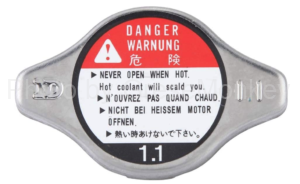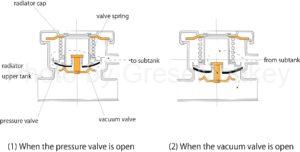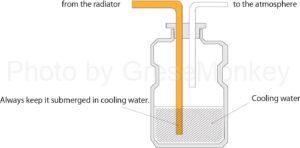radiator cap and subtank
table of contents
- The role and function of the radiator cap
- Actuation of the radiator cap
- sub tank
- References/Websites
The role and function of the radiator cap
As shown in Fig. 1, the radiator cap is equipped with a pressure valve (pressurization) and a vacuum valve (negative pressure), and a pressure type that constantly applies pressure to the cooling system is used.
This is done by sealing the radiator with a radiator cap, applying pressure inside the engine cooling line against the thermal expansion of the cooling water after the engine starts, preventing it from boiling even when the water temperature rises above 100°C, and preventing air bubbles. It suppresses the occurrence of , and enhances the cooling effect.
Reasons for increasing the boiling point of cooling water by applying pressure
In our living environment, water boils at 100°C under atmospheric pressure, but water has the property of boiling at 100°C or higher when pressure is applied above the atmospheric pressure. On the other hand, the combustion of automobile engines causes the temperature to rise steadily, and the cooling water boils quickly unless pressure is applied. In order to cool the engine with water (cooling water), boiling at 100°C under atmospheric pressure will not cool the engine.
Therefore, pressure is applied to the cooling water passage in the engine and the radiator, etc., through which the cooling water passes to cool the engine and keep it at an appropriate temperature, and the pressure is above atmospheric pressure so that it does not boil at 100 ° C.
If the coolant boils for some reason, air will be generated in the coolant and the engine will not be able to cool properly, resulting in overheating.
Even if you say that the engine is cooled with cooling water, it does not simply cool the engine because it gets hot. It is a device to keep it at an appropriate temperature according to its performance.
Actuation of the radiator cap
The radiator cap keeps the inside of the radiator airtight by closing both the pressure valve and the vacuum valve when the inside of the radiator is within the specified pressure.
When the cooling water temperature rises as the engine rotates and the pressure inside the radiator rises above a specified pressure, the pressure valve opens as shown in Fig. 1 (1), and the cooling water that expands due to the temperature rise is sent to the sub-tank. Adjust the pressure inside.
When the engine stops and the cooling water temperature drops, the cooling water temperature drops and the expanded cooling water returns to its original state, creating negative pressure in the radiator. Then, as shown in Fig. 1 (2), the vacuum valve of the radiator cap opens and sucks cooling water from the sub-tank until the negative pressure disappears.
sub tank
When the temperature of the cooling paper in the radiator rises and the volume expands, the sub-tank stores the amount of cooling water that cannot be stored in the radiator. Conversely, when the temperature of the cooling water drops and the volume shrinks , a negative pressure is generated in the radiator and the cooling water in the sub-tank is returned to the radiator, and the amount of the cooling water in the radiator is always kept constant.
In order to perform these functions, the entire cooling line through this radiator and the engine body must be sealed at all times. In other words, it is to prevent air (bubbles) from entering the engine cooling line.
Air entrainment increases the risk of overheating without the cooling water pressure functioning normally. It is necessary to pay attention to leakage of cooling water and to remove air from the cooling water during overhaul and repair.
Pay attention to the hose that connects the sub tank and the radiator cap part
When inspecting the cooling water, be sure to check the amount of cooling water using the “Hi” and “Low” gauges marked on the sub-tank as a guide. It is necessary to judge whether or not the removal was done just badly, but if these are not appropriate, it is necessary to suspect an abnormality in the cooling system. However, the fact that there is trouble with the sub-tank itself may be a surprisingly blind spot.
The squid failure example is an example of trouble caused by neglecting to inspect the sub-tank itself. I think that it is one of the cases that should be referred to by all means.
References/Websites
This site has been quoted and referenced from the following documents and sites.
- Class 3 automobile gasoline engine | Federation of Japan Automobile Maintenance Association
https://www.jaspa.or.jp/association/publication/book_k3gaen.html
- Automotive Engine Cooling Technology: Written by Takeo Hashimoto | Grand Prix Publishing


